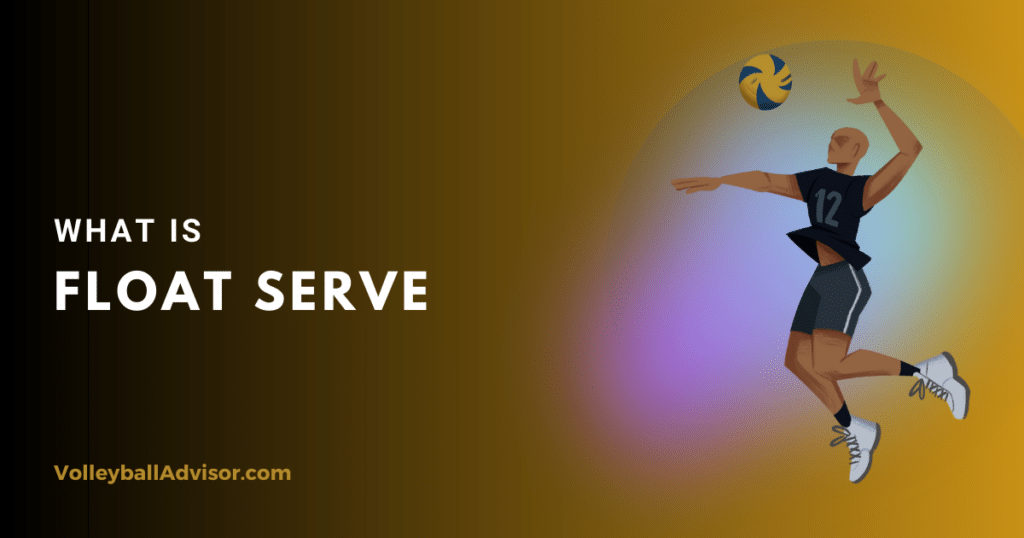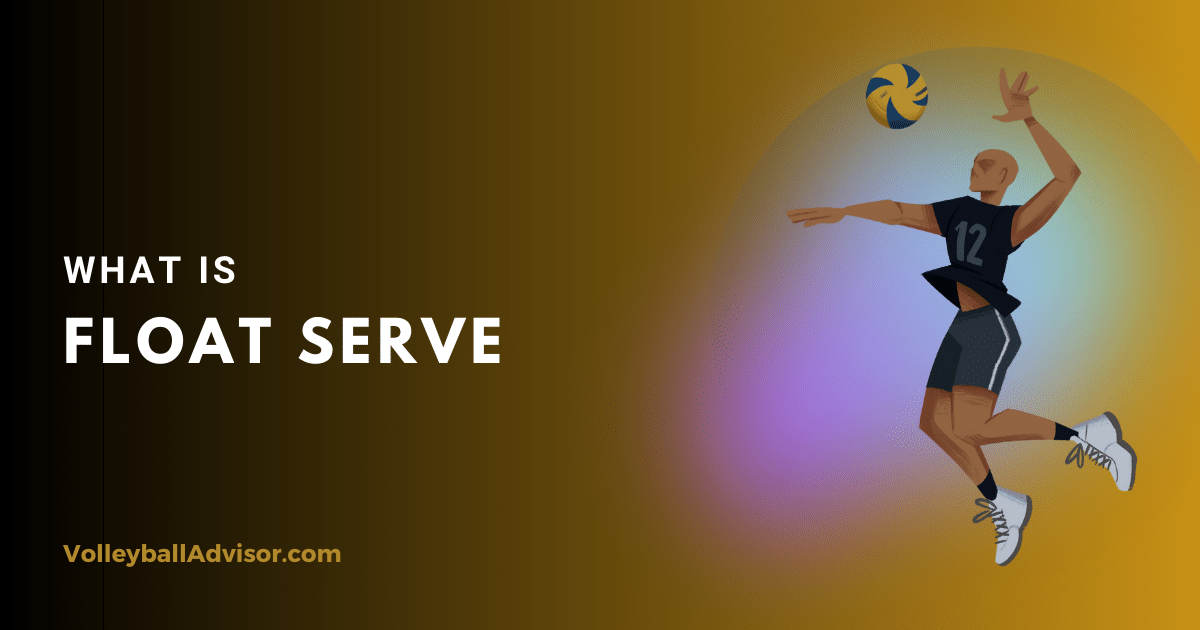Volleyball is a dynamic and exciting sport that requires a blend of skill, strategy, and athleticism.
As a player, I’ve always been fascinated by the various techniques that can give a team the upper hand in a match.
One such technique is the float serve, which has become increasingly popular in recent years due to its unpredictable nature and tactical advantages.
A float serve in volleyball is a serve characterized by its lack of spin and unpredictable flight path. When executed correctly, the ball appears to “float” through the air, making it difficult for receivers to anticipate its movement. This serve relies on specific techniques to create its distinctive motion and is valued for its tactical advantages in disrupting the receiving team’s rhythm.
In this article, I will be delving into the world of float serves, discussing their importance in volleyball and the role they play in a player’s arsenal.
What Is A Float Serve In Volleyball?
The float serve is a type of volleyball serve characterized by its lack of spin and unpredictable trajectory. When executed correctly, the ball will move through the air with minimal rotation, making it difficult for the receiving team to predict its path and respond accordingly.

This can lead to errors on the receiving side, ultimately giving the serving team an advantage in the game.
Importance of serves in volleyball
Serves are a crucial aspect of volleyball, as they initiate each rally and can set the tone for the rest of the play.
A strong, well-placed serve can put pressure on the receiving team, forcing them into a defensive position and limiting their offensive options.
Conversely, a weak serve can easily be exploited by the opposition, leading to a quick point for the receiving team.
Therefore, mastering a variety of serves, including the float serve, is essential for any serious volleyball player.
The role of float serve in a player’s arsenal
The float serve is an invaluable weapon in a player’s serving arsenal.
Its unpredictability and versatility make it a highly effective tool for disrupting the receiving team’s rhythm and exploiting their weaknesses.
By mastering the float serve, a player can become a more complete and formidable opponent on the court, able to adapt their serving strategy to any situation and keep their opponents guessing.
Understanding the Float Serve
The float serve is a unique type of volleyball serve that is characterized by its lack of spin and unpredictable flight path.
When executed properly, the ball appears to “float” through the air, making it difficult for receivers to anticipate its movement and react accordingly.
This serve relies on a specific set of techniques to generate its distinctive motion, which I will discuss in more detail in the following sections.
Read More:-
Physics behind the float serve
No spin motion
The key to a successful float serve lies in the absence of spin. When a ball is struck without spin, it travels through the air in an unstable manner, causing it to wobble and change direction unexpectedly.
This contrasts with a traditional topspin or jump serve, where the ball’s rotation creates a more predictable flight path.
Eliminating spin from your serve requires precise hand contact and a controlled follow-through, which can be challenging to master but ultimately rewarding.
Airflow and turbulence
Another factor contributing to the unpredictable nature of the float serve is the way air interacts with the ball as it moves through the air.
When a ball is hit without spin, the air pressure around it becomes uneven, leading to an effect known as the Magnus force.
This force can cause the ball to change direction suddenly, making it difficult for receivers to predict its path. Additionally, the seams on the ball can create turbulence as it moves through the air, further adding to its erratic movement.
Unpredictable trajectory
The combination of the no spin motion and the effects of airflow and turbulence results in the float serve’s unpredictable trajectory.
This serves to keep the receiving team off-balance and guessing, increasing the likelihood of errors and miscommunications.
As a server, being able to consistently produce this kind of movement with your float serve can be a game-changing advantage, forcing your opponents to adapt to your unpredictable style and giving your team the upper hand in any given match.
Benefits of the Float Serve
Catching opponents off-guard
One of the main tactical advantages of the float serve is its ability to catch opponents off-guard.
Due to its unpredictable trajectory, the float serve can disrupt the receiving team’s rhythm and make it difficult for them to coordinate their response.
This can lead to errors in passing, setting, and even attacking, providing the serving team with opportunities to score points and gain momentum.
Exploiting weak receivers
Another tactical advantage of the float serve is its potential to exploit weak receivers on the opposing team.
By targeting players who struggle with serve reception, you can maximize the chances of creating errors or forcing the receiving team into less-than-ideal situations.
This can not only lead to points for your team, but also put additional pressure on the opposition, potentially leading to further mistakes and breakdowns in their game.
Lower risk of error
In comparison to more advanced serves like the jump serve or the topspin serve, the float serve generally carries a lower risk of error.
This is because the float serve does not require as much power or precision, making it more forgiving and easier to execute consistently.
This can be a valuable asset, especially in high-pressure situations where minimizing errors is crucial to maintaining control of the game.
Versatility and adaptability
The float serve’s versatility and adaptability make it a valuable weapon for players of all skill levels and positions.
Because the float serve can be executed from both the standing and jumping positions, it allows players to adapt their serving style to the specific needs of their team and the situation at hand.
Furthermore, the float serve can be targeted to various areas of the court, allowing the server to exploit gaps in the opposition’s defense or create advantageous matchups for their team.
This flexibility and strategic potential make the float serve an essential part of any volleyball player’s repertoire.
Techniques for Executing a Successful Float Serve
Proper stance and positioning
The first step in executing a successful float serve is to adopt the correct stance and positioning. Stand with your feet shoulder-width apart and slightly staggered, with your non-dominant foot slightly forward. Your weight should be evenly distributed, and your knees should be slightly bent. Face the net, with your body angled slightly towards your target area on the court.
Ball toss and hand contact
A consistent and controlled ball toss is crucial for a successful float serve. With your non-dominant hand, toss the ball about 1-2 feet into the air, ensuring that it remains in line with your hitting shoulder. As the ball descends, make contact with the center of the ball using the heel of your hand, ensuring that your fingers do not wrap around the ball. This will help to minimize spin and generate the desired “floating” effect.
Body and arm movement
As you prepare to strike the ball, bring your hitting arm back in a relaxed, bent position. Focus on keeping your shoulder and elbow aligned throughout the entire movement. As you make contact with the ball, extend your arm fully and follow through with a controlled, smooth motion. Avoid snapping your wrist, as this can impart spin on the ball and negate the float serve’s desired effect.
Tips for generating a no-spin motion
To successfully generate a no-spin motion, focus on making clean, solid contact with the center of the ball. Keep your hand firm and flat at the moment of contact, and avoid any wrist movement that could impart spin. Additionally, maintaining a consistent and controlled follow-through will help to ensure that your float serve remains spin-free and unpredictable.
Variations and adaptations
Jump float serve
For players who are comfortable with the basic float serve, the jump float serve can be an effective variation.
To execute a jump float serve, perform a short, controlled jump as you toss the ball, striking it at the peak of your jump.
This can add an element of surprise and increase the serve’s difficulty for receivers to handle.
Short and deep float serves
Another way to keep your opponents guessing is by varying the depth of your float serves.
By alternating between short and deep serves, you can exploit gaps in the opposing team’s defense and force them to constantly adjust their positioning.
Experiment with different target areas on the court to find the most effective strategies for your specific opponents.
Difference Between Float Serve And Jump Serve
| Aspect | Float Serve | Jump Serve |
|---|---|---|
| Ball trajectory | Unpredictable, “floating” motion | Predictable, typically with topspin |
| Spin | No spin or minimal spin | Significant topspin or spin |
| Technique | Standing or small jump | Approach with a powerful jump |
| Contact point | Center of the ball | Top of the ball |
| Wrist movement | Minimal or no wrist snap | Pronounced wrist snap |
| Speed | Slower, more controlled | Faster, more powerful |
| Difficulty to execute | Easier, lower risk of error | More challenging, higher risk of error |
| Tactical advantages | Unpredictable, exploits weak receivers | Speed, can force opponents out of system |
| Required skill level | Suitable for players of all skill levels | Generally for more advanced players |
Why Are Float Serves Hard to Receive in Volleyball?
Float serves are challenging to receive in volleyball primarily due to their unpredictable trajectory caused by the lack of spin and the resulting Magnus force and turbulence.
This erratic movement makes it difficult for receivers to read the server’s intention, anticipate the ball’s landing, and position themselves accordingly.
Additionally, float serves can be targeted at specific players or areas on the court, exploiting weaknesses in the receiving team’s defense.
The uncertainty surrounding the float serve creates mental pressure on receivers, and the varying speeds and depths of the serve further contribute to its difficulty.
Overall, the float serve’s unique characteristics make it a formidable weapon in volleyball, posing significant challenges for the receiving team.
Conclusion
Mastering the float serve is an essential skill for volleyball players at all levels of the game. Its unpredictable trajectory, tactical advantages, and versatility make it a valuable weapon in any player’s arsenal.
By focusing on proper stance, positioning, ball toss, hand contact, and body movement, you can develop a consistent and effective float serve that will keep your opponents guessing and give your team an edge on the court.
As with any skill in volleyball, the key to perfecting the float serve is practice and adaptation.
Continually refine your technique, experiment with variations like the jump float serve and targeting different areas of the court, and be prepared to adjust your serving strategy based on the specific needs of your team and the situation at hand.
In conclusion, the float serve is a crucial element of modern volleyball and has the potential to greatly enhance a player’s serving repertoire.
By dedicating time and effort to mastering this skill, you can become a more formidable and well-rounded player, capable of making a significant impact in any match.
